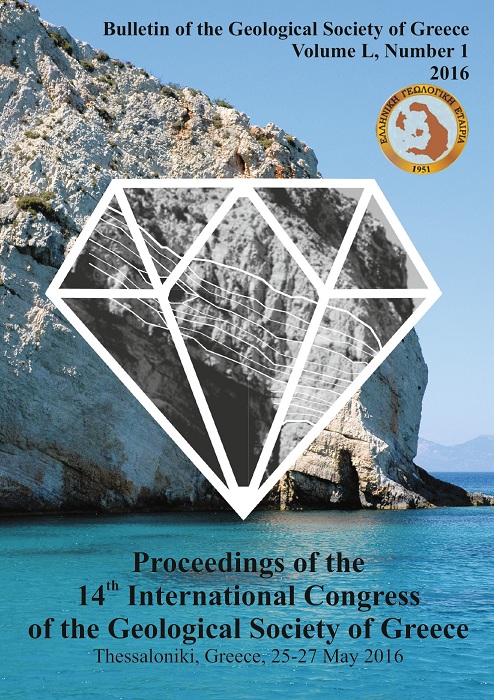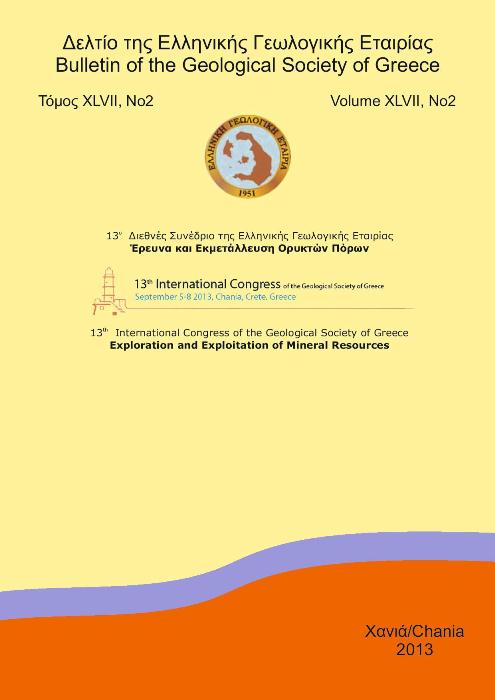QUANTITATIVE ANALYSIS OF DEFORMATION ALONG THE FAULT DAMAGE ZONE OF THE KLIMATIA THRUST (NW GREECE, IONIAN ZONE)
Περίληψη
In this study, we present structural, fracture orientation and fracture density (FD) data in order to quantify the deformation pattern of a damage zone that form around the slip plane of a large scale thrust fault which is located on the Ionian zone (External Hellenides) in northwestern Greece. Structural analysis showed at least two major deformation stages as indicated by the presence of refolding, backthrusting and break-back faulting. The fracture orientation analysis revealed three main fracture systems, a dominant conjugate fracture system which is perpendicular to the transport direction (NW-to NNW trending sets), a conjugate fracture system trending parallel to the transport direction (ENE-trending conjugate sets) and a third diagonal conjugate fracture system (WNW and NNE trending sets). Resulting fracture density distance diagrams display a decrease of total fracture density away from the studied fault, which is largely heterogeneous and irregular on both footwall and hanging wall. The conjugate fracture system trending perpendicular to the transport direction has the dominant contribution to the accumulation of total fracture density. Based on these results we suggest that the observed heterogeneous and irregular distribution of fracture density fashioned during the second deformation stage and is attributed to the formation of backthrusts and break-back thrust faults.
Λεπτομέρειες άρθρου
- Πώς να δημιουργήσετε Αναφορές
-
Kostakioti, A., Xypolias, P., Kokkalas, S., & Doutsos, T. (2004). QUANTITATIVE ANALYSIS OF DEFORMATION ALONG THE FAULT DAMAGE ZONE OF THE KLIMATIA THRUST (NW GREECE, IONIAN ZONE). Δελτίο της Ελληνικής Γεωλογικής Εταιρείας, 36(4), 1643–1651. https://doi.org/10.12681/bgsg.17328
- Ενότητα
- Τεκτονική και Γεωδυναμική

Αυτή η εργασία είναι αδειοδοτημένη υπό το CC Αναφορά Δημιουργού – Μη Εμπορική Χρήση 4.0.
Οι συγγραφείς θα πρέπει να είναι σύμφωνοι με τα παρακάτω: Οι συγγραφείς των άρθρων που δημοσιεύονται στο περιοδικό διατηρούν τα δικαιώματα πνευματικής ιδιοκτησίας επί των άρθρων τους, δίνοντας στο περιοδικό το δικαίωμα της πρώτης δημοσίευσης. Άρθρα που δημοσιεύονται στο περιοδικό διατίθενται με άδεια Creative Commons 4.0 Non Commercial και σύμφωνα με την οποία μπορούν να χρησιμοποιούνται ελεύθερα, με αναφορά στο/στη συγγραφέα και στην πρώτη δημοσίευση για μη κερδοσκοπικούς σκοπούς. Οι συγγραφείς μπορούν να: Μοιραστούν — αντιγράψουν και αναδιανέμουν το υλικό με κάθε μέσο και τρόπο, Προσαρμόσουν — αναμείξουν, τροποποιήσουν και δημιουργήσουν πάνω στο υλικό.








